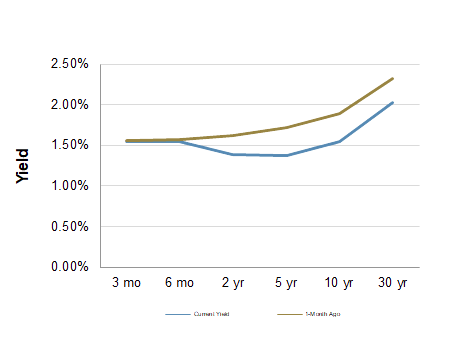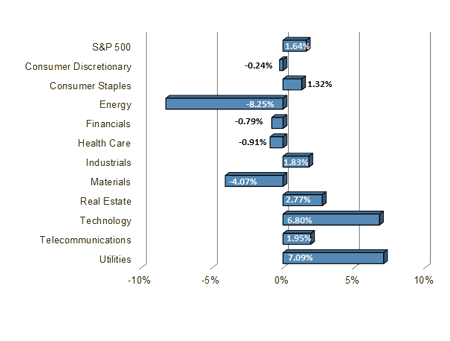Weekly Market Snapshot
Chief Economist Scott Brown discusses the latest market data.
There were no surprises from the Fed and the economic data. Investors remained concerned about the impact of the Wuhan coronavirus. By the end of the week, there were nearly 10,000 reported cases and more than 200 reported dead. The shutdown of travel and economic activity will result in slower growth in China and neighboring countries. Activity will rebound once the outbreak is contained, but that may take some time.
The FOMC left the target range for the federal funds rate unchanged (at 1.50-1.75%). Chair Powell repeated that officials believe that the stance of monetary policy was “appropriate,” but signaled a willingness to respond if there were to be a material reassessment of the economic outlook. Asked about the virus, Powell said that there will be some disruptions to activity in China and the rest of the world, but “the situation is in the early stages and it’s very uncertain how far the virus will spread.” The federal funds futures market began to price in some chance of a rate cut in the months ahead (more than 50% by June).
Real GDP rose at a 2.1% annual rate in the advance estimate for 4Q19 (+2.3% y/y), matching the median forecast. As expected, consumer spending growth moderated (following two strong quarters), business fixed investment continued to weaken, and residential homebuilding improved. Slower inventory growth (partly related to the strike at GM) subtracted 1.1 percentage points from GDP growth, while net exports (a narrower trade deficit) added 1.5 percentage points. Private Domestic Final Purchases, the better measure of underlying domestic demand, rose at a 1.4% pace (+2.2% y/y).
Next week, concerns about the Wuhan coronavirus should remain at the forefront. The economic calendar remains busy, with a focus on the employment report. The monthly payroll figures will be subject to more than the usual statistical noise. Prior to seasonal adjustment, we normally lose about three million jobs each January. Annual benchmark revisions add further uncertainty, and are expected to lower the March 2019 level of payrolls by 500,000 (-0.3%).
Indices
| Last | Last Week | YTD return % | |
|---|---|---|---|
| DJIA | 28859.44 | 29160.09 | 1.12% |
| NASDAQ | 9298.93 | 9402.48 | 3.64% |
| S&P 500 | 3283.66 | 3325.54 | 1.64% |
| MSCI EAFE | 1999.03 | 2036.49 | -1.86% |
| Russell 2000 | 1648.22 | 1685.01 | -1.21% |
Consumer Money Rates
| Last | 1 year ago | |
|---|---|---|
| Prime Rate | 4.75 | 5.50 |
| Fed Funds | 1.75 | 2.40 |
| 30-year mortgage | 3.49 | 4.43 |
Currencies
| Last | 1 year ago | |
|---|---|---|
| Dollars per British Pound | 1.309 | 1.311 |
| Dollars per Euro | 1.103 | 1.145 |
| Japanese Yen per Dollar | 108.96 | 108.89 |
| Canadian Dollars per Dollar | 1.321 | 1.313 |
| Mexican Peso per Dollar | 18.780 | 19.106 |
Commodities
| Last | 1 year ago | |
|---|---|---|
| Crude Oil | 52.14 | 53.79 |
| Gold | 1589.20 | 1325.20 |
Bond Rates
| Last | 1 month ago | |
|---|---|---|
| 2-year treasury | 1.38 | 1.63 |
| 10-year treasury | 1.55 | 1.89 |
| 10-year municipal (TEY) | 1.83 | 2.29 |
Treasury Yield Curve – 01/31/2020

As of close of business 01/30/2019
S&P Sector Performance (YTD) – 01/31/2020

As of close of business 01/30/2019
Economic Calendar
| February 3 | — | ISM Manufacturing Index (January) |
| — | Iowa Caucus | |
| February 4 | — | Factory Orders (December) |
| — | State of the Union Address | |
| February 5 | — | ADP Payroll Estimate (January) |
| — | Trade Balance (December) | |
| — | ISM Non-Manufacturing Index (January) | |
| February 6 | — | Challenger Job-Cut Report (January) |
| — | Jobless Claims (week ending February 1) | |
| February 7 | — | Employment Report (January) |
| — | Monetary Policy Report to Congress | |
| February 11 | — | Powell Monetary Policy Testimony |
| February 14 | — | Retail Sales (January) |
| February 17 | — | Presidents Day Holiday (markets closed) |
All expressions of opinion reflect the judgment of the Research Department of Raymond James & Associates, Inc. and are subject to change. There is no assurance any of the forecasts mentioned will occur or that any trends mentioned will continue in the future. Investing involves risks including the possible loss of capital. Past performance is not a guarantee of future results. International investing is subject to additional risks such as currency fluctuations, different financial accounting standards by country, and possible political and economic risks, which may be greater in emerging markets. While interest on municipal bonds is generally exempt from federal income tax, it may be subject to the federal alternative minimum tax, and state or local taxes. In addition, certain municipal bonds (such as Build America Bonds) are issued without a federal tax exemption, which subjects the related interest income to federal income tax. Municipal bonds may be subject to capital gains taxes if sold or redeemed at a profit. Taxable Equivalent Yield (TEY) assumes a 35% tax rate.
The Dow Jones Industrial Average is an unmanaged index of 30 widely held stocks. The NASDAQ Composite Index is an unmanaged index of all common stocks listed on the NASDAQ National Stock Market. The S&P 500 is an unmanaged index of 500 widely held stocks. The MSCI EAFE (Europe, Australia, Far East) index is an unmanaged index that is generally considered representative of the international stock market. The Russell 2000 index is an unmanaged index of small cap securities which generally involve greater risks. An investment cannot be made directly in these indexes. The performance noted does not include fees or charges, which would reduce an investor’s returns. U.S. government bonds and treasury bills are guaranteed by the US government and, if held to maturity, offer a fixed rate of return and guaranteed principal value. U.S. government bonds are issued and guaranteed as to the timely payment of principal and interest by the federal government. Treasury bills are certificates reflecting short-term (less than one year) obligations of the U.S. government.
Commodities trading is generally considered speculative because of the significant potential for investment loss. Markets for commodities are likely to be volatile and there may be sharp price fluctuations even during periods when prices overall are rising. Specific sector investing can be subject to different and greater risks than more diversified investments. Gross Domestic Product (GDP) is the annual total market value of all final goods and services produced domestically by the U.S. The federal funds rate (“Fed Funds”) is the interest rate at which banks and credit unions lend reserve balances to other depository institutions overnight. The prime rate is the underlying index for most credit cards, home equity loans and lines of credit, auto loans, and personal loans. Material prepared by Raymond James for use by financial advisors. Data source: Bloomberg, as of close of business January 30, 2020.

